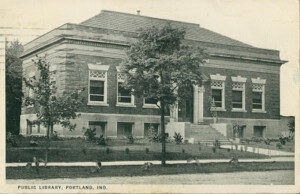Over 100 Years of Public Library Service
Prior to the Civil War, Dr. D. E. McNeal, local physician and school teacher, maintained a library collection in the Miller building on Main Street in Portland, Indiana, but the library declined during the war years. In 1897, the Portland Alumni Association and city school teachers inaugurated a movement to revive library service. They held a book shower to acquire materials for a room in the Bimel building at the southeast corner of Main and Meridian Streets.
The Carnegie Building
Throughout the next three formative years, a board of trustees was named, and by early 1901 librarian Mellie Stanley reported holdings of 1,414 books with an annual circulation of 15,763. Later that year library officials solicited construction funds from the Carnegie Foundation: $15,000 was given for construction with the proviso that the City provide one-tenth that amount each year for maintenance. The building was dedicated in 1902.
Library service extended to Wayne Township residents in 1919 and to the rest of the county by contract in 1946. Bookmobile service and a branch location in Pennville were added in 1948.
Growing and Growing
In 1973, a $150,000 two-story addition on the north side of the Carnegie structure was dedicated, creating a split-level building with four floors.
The Portland-Jay County Contractual Library reorganized in 1976 and became the Jay County Public Library, serving all residents of the county except those within Pennville, Penn Township, and the City of Dunkirk, who were served by their own public libraries.
In the mid-1980s, the Board of Trustees began to explore solutions to several growing challenges: lack of space for a diversified collection of materials, limited space for programming and patron reading and study, increased staff size driven by increased usage, and physical problems with the current structure. A 1985 feasibility study advocated constructing a building twice the size at a new location, or, in the alternative, doubling the size of the current structure. Library usage continued to increase–from an annual circulation of 170,000 in 1970–to over 280,000 in 1992. The new Americans with Disabilities Act moved the Board of Trustees from contemplative–to action mode.
The library entered the computer age in 1989, when records for some 100,000 books and non-print items were entered into a circulation control database. Another major commitment to automation was made in 1993, when the library’s circulation control system was expanded to provide Online Public Access Catalogs (OPACs), to replace the traditional card catalogs. Additional computer stations were also made available to the public and staff.
To Build or Not to Build
The construction project for the current structure began with meetings in 1992 that involved board, staff, and citizens representing a broad spectrum of the community. The group identified the physical facility as a major concern.
The Board continued their study and deliberations on the project throughout 1993, gathering ideas from architects and seeking citizen input through surveys and public meetings. A flooded basement during the summer heightened concern. The Board of Trustees hired the K. R. Montgomery & Associates of Anderson to complete a feasibility study, and in 1994 the Board decided the best option was to build a new structure on North Ship Street in Portland. The design provided for 21,163 square feet on the ground floor with estimated construction costs of $2,237,000.
A petition was filed to allow a $2,542,000 bond issue, but a remonstrance petition delayed financing for one year. An Independent Review Committee was appointed to review the library’s needs and potential solutions. After five months of meetings, the committee recommended building as planned, but holding the bond issue to $1,850,000 and waging a vigorous campaign for alternative funding.
Building Is On!
1995 saw plans scaled back and a bond issue approved. Buoyed by notification of grant awards and the success of local fund raising efforts, the Board of Trustees made provision for returning plans to the original level as funds became available and contracted W. A. Sheets & Sons of Fort Wayne for the construction project. Ground was broken in early October 1995.
By the spring of 1996, local donations topped $600,000. The old library structure was sold in the summer and construction was substantially completed. The old building was closed to the public on October 12. After the efforts of staff, volunteers, and Library Relocation Consultants of Bloomington, the new location was dedicated and opened to the public on October 26.
Celebrating 100 Years of Public Library Service
A Book Shower held in honor of the Centennial was completed in 2002. Gifts may still be made to the library, however. Learn more about making gifts to the library in honor or in memory of someone special.
Check out these articles on the library’s centennial:
A JCPL Timeline from early beginnings up to Centennial Year
Special Centennial Edition of Newsnotes
The Library Goes Evergreen
In 2009, the library joined the Evergreen Indiana consortium, sharing catalogs and circulation with other Evergreen libraries in Indiana. Borrowers enjoy access to more items and a greater ability to manage their own library accounts. The consortium itself continues to grow with 126 member libraries as of July 2021.

